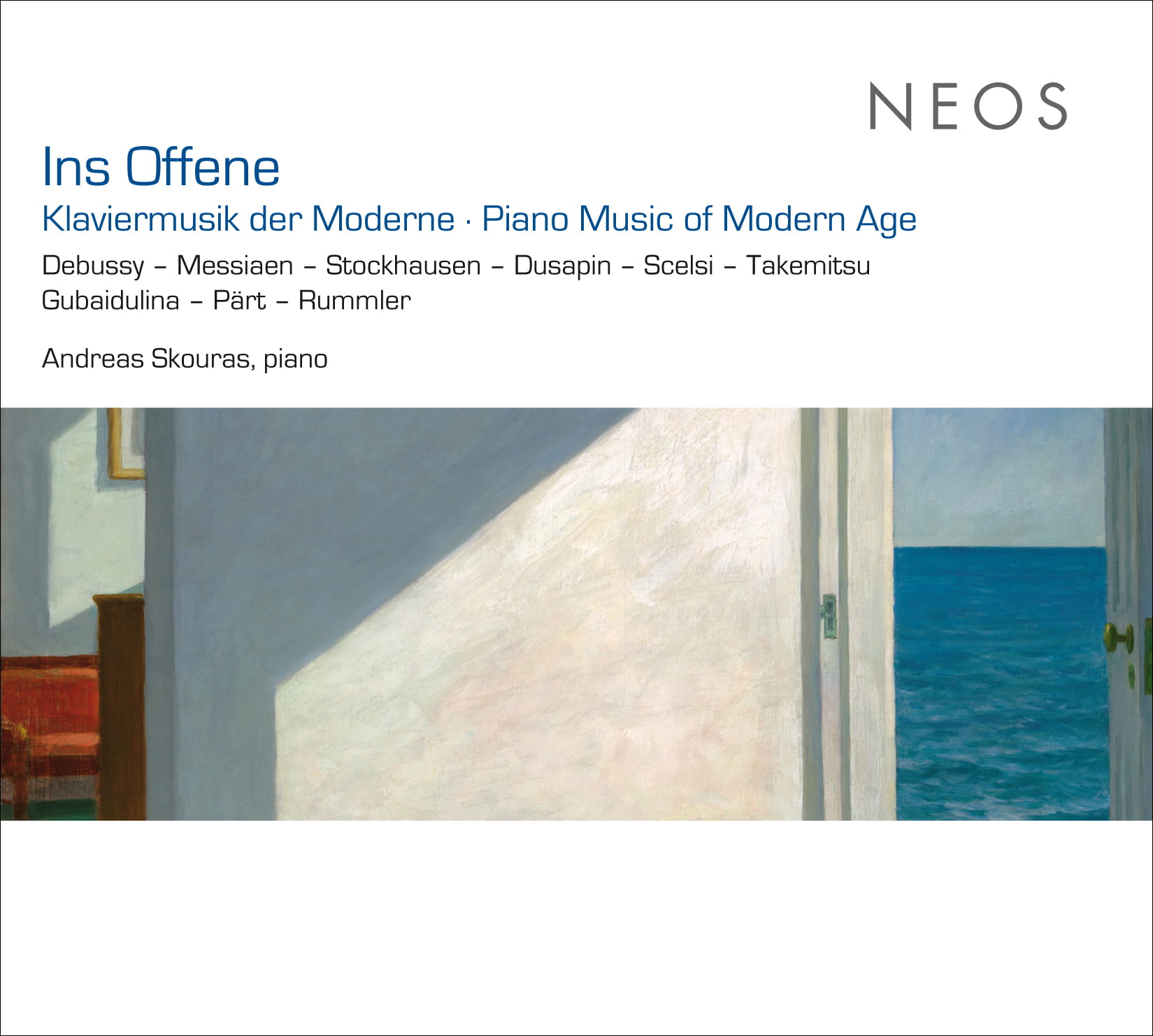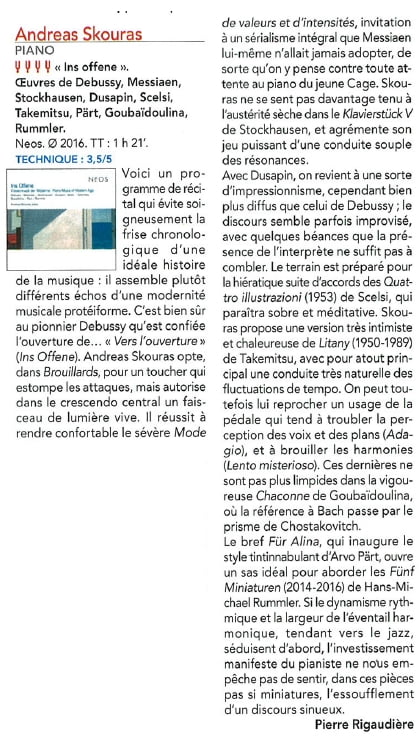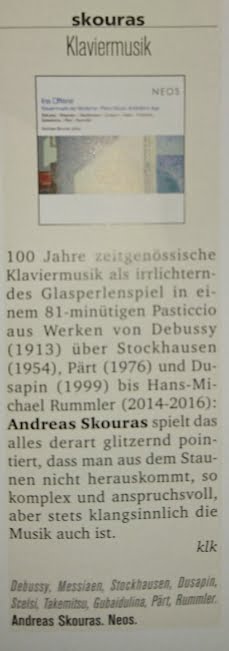infotext:
INTO THE OPEN – MODERN PIANO MUSIC Since modern music has radically emancipated itself from its historically evolved “world of concepts and feelings” (Nietzsche), composers, eagerly trying to free themselves from the standards, models and experiences of the past, have been moving on an indefinite, directionless journey into the open. Using a few selected piano works (from Debussy to the world premiere of the Five Miniatures), I would like to show how composers shape this self-consuming, continuously renewing process of modernity in a highly individual and divergent manner and how openness is created through their works in the first place. Their selection necessarily remains subjective as well as historically selective. This conceptually open and sophisticated presentation of aesthetically and stylistically diverse, conceptually incomprehensible piano works is at the same time a musically varied, contrasting, heterogeneous and sensual journey into modern piano music. Consequently, the works presented can only reflect a snapshot of modernity and the individual creative process of the composer. With these musical experiences, I would also like to give an insight into the irreconcilable difficulties of composing and to show how each of the composers presented here constantly seeks and »composes« their own personal musical path, free from traditions, rules and aesthetic concepts in latent uncertainty and aimless orientation towards the future. Her works testify to an attempt to overcome the antinomies of modernity by pointing them into the open. With »modernity« (as an epochal concept), which announced itself as a break with tradition even before 1900, a diverse and at the same time heterogeneous experience of upheaval by forces striving apart is in the offing: on the one hand, people are fixated on the ideology of progress, pay homage to science and rave about beauty of technology, speed and noise, on the other hand the crisis of tradition announces the growing understanding of the work, musical material, self-image of the artist, formal language, tonality, optimism about progress and linear understanding of history, which manifested itself in musically diverse and very different movements, approaches and styles. It is Claude Debussy, on the threshold of modernity, who still maintains the balance between conventional structures and new timbres. He experiments with medieval modes as well as with jazz rhythms, absorbs suggestions from non-European cultures and thus promotes the "emancipation of dissonance" and consistently follows the path to musical abstraction. The structural procedures derived from the musical material are only recognized and further developed by the serialists. Like many representatives of modernism, he used the piano as a musical laboratory. The Prélude no 1 »Brouillards« (1913) already brings all the ingredients of the emerging modern age to life: this forward-looking sound composition dispenses with theme and development as well as with a clear key. The dissolution of tonal compositional techniques continues in the loss of the traditional form and loses its meaning - what remains is a composed process of timbres, of structured sound movements. At the latest after the experiences of two world wars, dictatorships and euphoria for progress, the utopia and nightmare of modernity came to an end. In the »awareness of an epochal threshold«, the special situation after 1945 also led to a paradigm shift in music. The new avant-garde, serial music went far beyond the Viennese school, wanted to create a fundamental renewal and in the search for "a schoolmaster of the objective and the organization" (Thomas Mann) lost orientation, time and subjectivity. Olivier Messiaen's Etude Mode de valeurs et d'intensités (1949), a compositional »practice piece« that made history, is considered the key work of serial music. The compositional procedure is based on Messiaen's system of modes and rhythms, which he explains in the foreword: »This piece carries out the coupling of tone durations, pitches, types of attack and intensities. It uses a mode consisting of 26 pitches, 24 durations, 12 velocities and 7 degrees of intensity. It is written exclusively in this mode, ie it uses no pitch other than the 36 pitches chosen; these tones always remain fixed in the octave once chosen, each coupled with its intended duration, attack and volume.« This paved the way to serialism, for a self-organizing music of aesthetic objectivity that was thoroughly organized according to the mathematical ideal. The musical parameters: pitch, rhythm (now: duration), degrees of intensity, types of attack, articulation through to form (now: structure) and space were quantified and reorganized. This pseudo-mathematical thorough rationalization of the musical material was made absolute during the composition by consciously dispensing with mimesis, meaning, motifs and subjectivity, while ignoring its own historicity. It was believed that meaning created itself qua technical rationality, as an object of progress. It was Karlheinz Stockhausen who believed he recognized his visionary, anti-subjective understanding of »purity« in Messiaen's etude and, like Boulez, drew on it. Stockhausen continued to pursue the mathematically strict development of serialism in the second cycle of his piano works. In the Piano Piece V (2), a composition of serially structured sound groups, Stockhausen experiments with time series and "uncertainty relations" as well as with rhythmic and melodic configurations. The work, with its partly new playing techniques, is just as extreme for the pianist as it refuses the traditional aesthetic perception for the listener. This paradigm shift into postmodernism (since the 60s), which points beyond a break in tradition, was not without consequences: in the skeptical awareness of modernism’s belief in progress, repressed, hidden and taboo positions of work, aesthetics, composers, composing, performance and tradition are increasingly gaining ground Meaning. This opens a window that makes the most diverse lines of development and new points of reference visible, thus opening up a view of unknown horizons. »The fraying of the arts« (Adorno) also leads to a pluralism of the most diverse aesthetic positions and highly heterogeneous works in music. The 7 Etudes for piano (1999-2001) by Messiaen and Xenakis student Pascal Dusapin cannot deny their French origins, they are characterized by restrained constructivism between neo-serialism and postmodernism. Tones and sounds, polyrhythms and microtonal melodies are harsh and edgy, impressionistically colorful and reduced, transparent and sparse in the etudes, which are very different in character but always composed with creative intensity. The Italian Giacinto Scelsi, who saw himself not as a composer but as a medium, made the most consistent departure from Western music, far beyond serialism. Only the artist can, through inspiration, produce sound (as tone), "the first movement of the unmoved," the writing of which is the responsibility of someone else, the craftsman. His spiritual music "changing sounds" moves in the boundless space between rationality and mysticism on the way to "purity" and "spirituality" and sees itself as "part of a divine unity". His forward-looking, meditative sound compositions, which penetrate into microtonality, as well as his Quattro illustrazioni (1953) for piano, are closed to analysis, "their gesture is refusal" (Carl Dahlhaus). The attempts at liberation from modern music pushed into the abstract with a timeless claim to validity also led to new discoveries outside of Europe: The Japanese Toru Takemitsu dealt with his »teacher« Messiaen as well as with Nono, Stockhausen and Cage, experimented with musique concréte and electronics and aleatoric music, which led him to return to his Japanese musical tradition. One result of his engagement with the European avant-garde, with Messiaen's modes and the traditional pentatonic scale of Japan was his early piano work Lento in due movimenti (1950), which was revised after 40 years and premiered as Litany (in Memory of Michael Vyner) in 1990. For him, nature as an aesthetic point of reference, as an attitude towards experience, becomes the power of stillness, just as it did for his "teacher" Debussy. The new sound and design spaces allow him to overcome "form mania" (Debussy). Cut off from musical developments after 1945 and unaffected by a wide variety of currents and styles in Western Europe, Sofia Gubaidulina developed her religiously influenced »naturally growing« personal style. In her works she deals with the musical tradition as well as with Webern and serial music. As a composer, she is committed to Romanticism as well as to her religious beliefs: »Composing is a religious act«, experiments with twelve-tone technique, with number symbolism as well as with various rhythmic processes and consciously writes clear and manageable works aimed at the listener. An early piano work is the Baroque-inspired Chaconne of 1963. The variations on an eight-bar theme are clearly structured formally, and the musical material, rhythm and tone move expressively, cautiously beyond traditional boundaries. Out of existential and religious experience, Arvo Pärt makes a radical departure from tried and tested compositional techniques of new music and finds his own personal compositional style by dealing with Gregorian chant. The two-part piano piece Für Alina (1976) is the first work composed in the tintinnabuli style he developed. The regularity and the minimalist approach to tradition, while renouncing "progress" in the musical material and avant-garde fashions, give his works formal clarity and tonal purism of great immediacy for the listener. The Five Miniatures (2014-2016) by Hans-Michael Rummler are a musical psychogram, a seismograph of personal sensitivities and at the same time a sound journey between the composing observer and the observed person. Tones are set selectively, added to lines or compressed into chords and combined with functionally ordered rhythms and intervals to create a piano piece full of power and intensity. The compositional work process is a meaningful balancing act between rational design and ambiguous experimentation. Always strictly constructed without appearing abstract, extremes are explored in terms of sound, with striking rhythms and often edgy, multi-tone chords. At the same time, well-measured lines lead to calm and provide orientation in time and space. Characteristic of my compositional style - whether piano or polyphonic choral works - is always a pronounced dramaturgy of formative power, as well as transparent, perceptible and recognizable music, full of sound intensity, expressive gestures, strongly pulsating rhythms, cantabile sensuality and calm. Hans Michael Rummler |
program:
Claude Debussy (1862-1918) Oliver Messiaen (1908-1992) Karlheinz Stockhausen (1928-2007)
Giacinto Scelsi (1905-1988) Pipe Takemitsu (1930-1996) Sofia Gubaidulina (* 1931) Arvo Part (* 1935) Hans Michael Rummler (* 1946) World Premiere Recordings Total playing time: 81:15 Andrew Skouraspiano |
Press:
November 2017
September 2017
January 2017
|






